Siding Remodel: When to Replace, What It Costs & How It Boosts Home Value
Contents
Introduction
Is It Worth Redoing Siding?
Is It Worth Replacing Siding on a House?
How Often Should Siding Be Replaced?
How Much Should It Cost to Replace Siding?
What Siding Will Increase Home Value?
Should 40-Year-Old Siding Be Replaced?
How Much to Side a 2000 Sq Ft House?
Conclusion: Why Choose HomeAdvisor USA for Your Siding Project
Introduction
Your home’s siding is more than just an aesthetic feature—it’s your property’s first line of defense against the elements. Over time, even the most durable siding materials can deteriorate, leading homeowners to consider the significant question: Is it time for a siding remodel?
At HomeAdvisor USA, we’ve helped thousands of homeowners across the country navigate siding replacement projects. Our network of skilled contractors has extensive experience with all siding materials and home styles, allowing us to provide insights based on real-world expertise rather than theoretical knowledge.
This comprehensive guide addresses the most common questions homeowners ask about siding remodels—from determining if replacement is truly necessary to understanding costs, value-adding materials, and project timelines. Whether your current siding is showing visible signs of damage or you’re simply exploring options to refresh your home’s exterior, this article will help you make informed decisions about your siding project.
Is It Worth Redoing Siding?
The question of whether a siding remodel is worthwhile encompasses several considerations—from protecting your home to enhancing its appearance and value. Here’s what HomeAdvisor USA’s siding experts want you to know:
Protection Value
“The primary purpose of siding is to protect your home’s structure,” explains Michael Reynolds, lead siding specialist at HomeAdvisor USA. “When siding begins to fail, it can allow moisture to penetrate your home’s framework, potentially leading to extensive and expensive damage.”
A siding remodel delivers significant protection value when:
- Existing siding shows signs of water damage or moisture intrusion
- Current materials are cracked, warped, or separating from the house
- You notice increased energy bills that may indicate poor insulation
- Interior walls show signs of moisture problems originating from outside
HomeAdvisor USA’s professional assessment can identify these issues, even in early stages when they might not be obvious to homeowners.
Aesthetic Value
Beyond protection, siding dramatically impacts your home’s curb appeal. A siding remodel can:
- Transform an outdated home exterior to a fresh, contemporary look
- Address faded, stained, or mismatched sections of existing siding
- Create a more cohesive aesthetic with modern design elements
- Allow for architectural upgrades like decorative trim or accent areas
“Many of our clients are amazed at how different their home looks after a siding remodel,” notes Sarah Martinez, design consultant with HomeAdvisor USA. “It’s like getting a completely new house without the cost of moving.”
Investment Value
According to industry data and HomeAdvisor USA project analysis, siding replacement consistently ranks among the top exterior remodeling projects for return on investment:
- Vinyl siding replacement typically recoups 70-75% of project costs in home value
- Fiber cement siding often returns 75-80% of the investment
- Premium materials and professional installation can increase these percentages
HomeAdvisor USA helps homeowners maximize this return by recommending materials and designs that appeal to the broadest range of potential future buyers in your specific market.
HomeAdvisor USA Insight: Our pre-project consultations include a detailed value analysis to help you understand the potential return on investment for different siding options in your specific neighborhood.
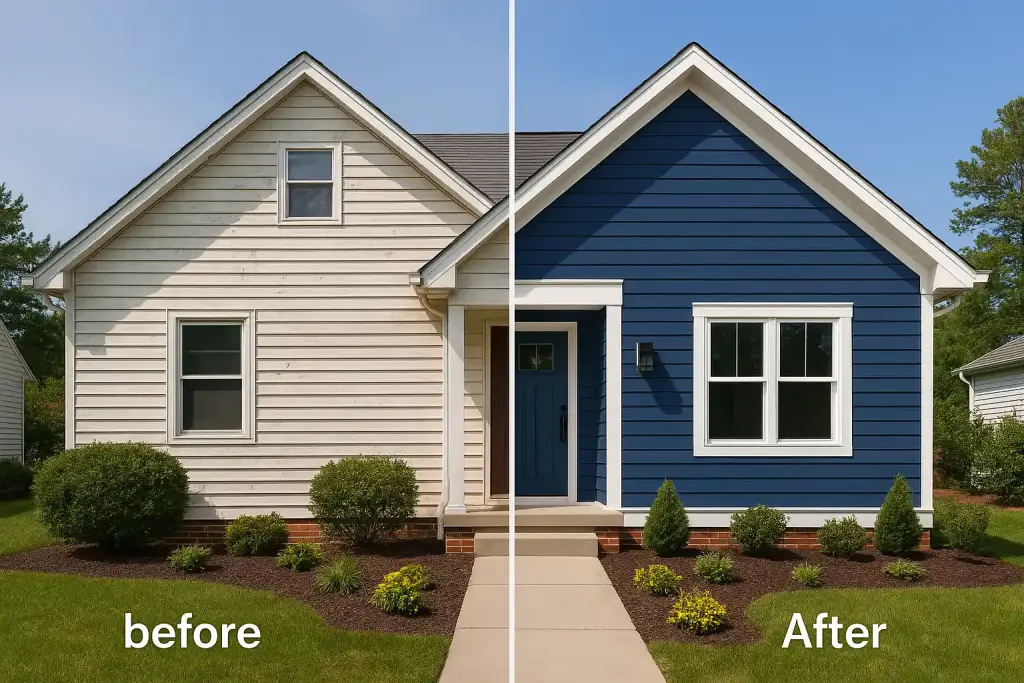
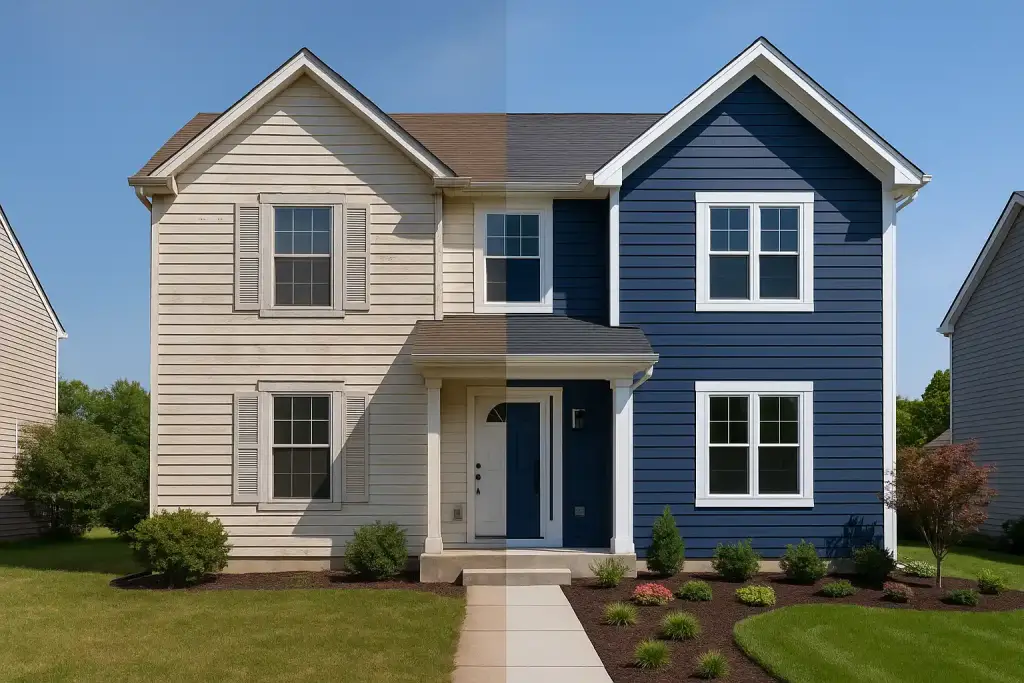
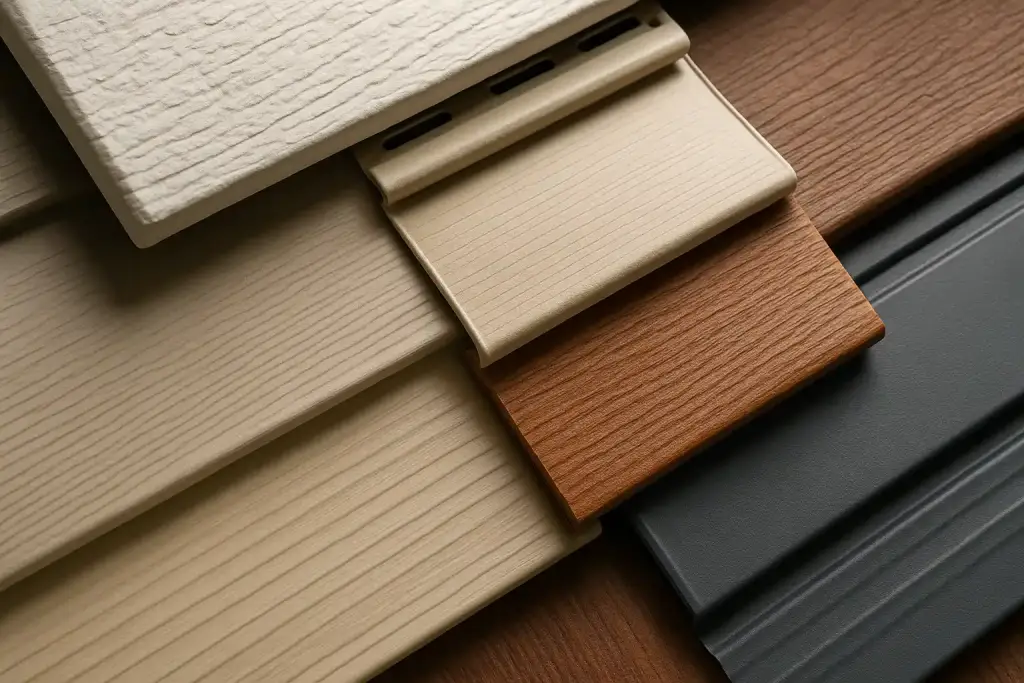
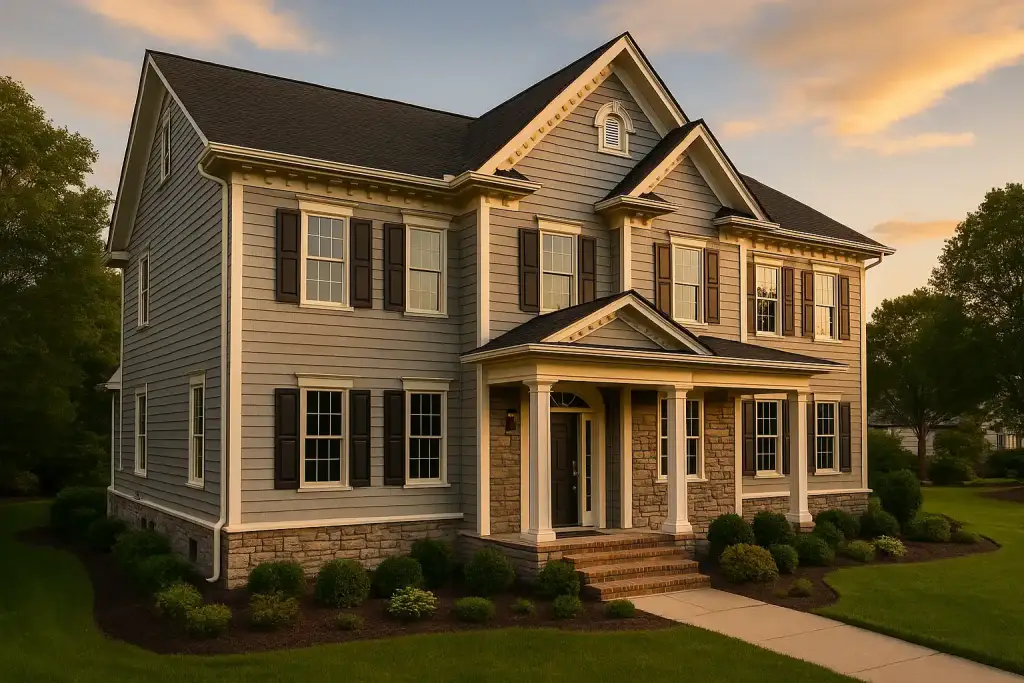
Is It Worth Replacing Siding on a House?
While the previous section addressed the general value of siding remodels, homeowners often need more specific guidance about their particular situation. Here’s how to determine if replacing siding is worthwhile for your specific home:
Signs Replacement Is Definitely Worth It
HomeAdvisor USA contractors look for these indicators that siding replacement has become necessary:
- Structural Damage: If your current siding has allowed water to damage the sheathing or framing behind it, replacement isn’t just worthwhile—it’s essential.
- Excessive Maintenance: When you’re spending more time and money maintaining your siding than enjoying your home, replacement with lower-maintenance materials becomes cost-effective.
- Significant Energy Issues: If your home is difficult to heat or cool despite adequate insulation elsewhere, new siding with integrated insulation can deliver substantial energy savings.
- Pre-Sale Preparation: For homeowners planning to sell within 1-5 years, siding replacement often delivers one of the best returns on investment compared to other exterior improvements.
- Historic or Hazardous Materials: Older homes may have asbestos siding or lead paint that presents health risks and requires professional remediation.
“We recently helped a client who was spending nearly $3,000 annually on painting and repairs to their deteriorating wood siding,” shares David Clark, HomeAdvisor USA project manager. “By switching to fiber cement, they eliminated those recurring costs while increasing their home’s value and appearance.”
When Partial Solutions Might Be Better
HomeAdvisor USA prides itself on honest assessments—sometimes a complete replacement isn’t necessary:
- Localized Damage: If problems are confined to one area (often on southern or western exposures), our contractors can sometimes replace just the affected sections.
- Cosmetic Issues Only: For siding that’s structurally sound but aesthetically dated, professional cleaning, painting, or targeted upgrades might be more cost-effective.
- Recent Previous Investment: If you’ve replaced siding within the past 10-15 years, addressing specific problem areas might make more financial sense.
HomeAdvisor USA Advantage: Unlike companies that only offer full replacements, our contractors provide honest assessments and can recommend targeted solutions when appropriate, potentially saving you thousands.
Return on Investment Considerations
To determine if replacement is financially worthwhile, HomeAdvisor USA helps clients consider:
- Remaining Time in Home: The longer you plan to stay, the more value you’ll personally derive from the investment.
- Neighborhood Standards: We help you avoid over-improving for your area while still meeting market expectations.
- Energy Efficiency Gains: Modern siding with integrated insulation can reduce heating and cooling costs by 20-30%, according to Energy Star data.
- Insurance Implications: Updated siding may qualify you for premium discounts with some insurance providers.
HomeAdvisor USA’s Professional Assessment: Our free siding consultations include a comprehensive evaluation of your current siding condition, helping you make an informed decision based on your specific circumstances rather than general guidelines.
How Often Should Siding Be Replaced?
Understanding typical siding lifespans helps homeowners anticipate replacement needs and budget appropriately. HomeAdvisor USA’s material specialists provide these guidelines based on real-world performance:
Lifespan by Material Type
Vinyl Siding:
- Standard Vinyl: 20-30 years
- Premium Vinyl: 30-40+ years
- Insulated Vinyl: 30-40+ years
Fiber Cement Siding:
- Typical Lifespan: 50+ years for the material itself
- Finish Durability: 15-20 years before repainting is typically needed
Wood Siding:
- Cedar and Redwood: 20-40 years with proper maintenance
- Pine and Spruce: 15-25 years with regular care
- Engineered Wood: 20-30 years depending on quality and exposure
Metal Siding:
- Aluminum: 20-40 years
- Steel: 40+ years
- Zinc or Copper: 50-100+ years
Stucco:
- Traditional Stucco: 50-80+ years with proper maintenance
- Synthetic Stucco (EIFS): 20-30 years
“While these timelines provide general guidance, we’ve seen significant variations based on climate, installation quality, and maintenance practices,” notes Jennifer Martinez, materials specialist at HomeAdvisor USA. “Professional installation by qualified contractors like ours can extend these lifespans by 20-30%.”
Factors That Accelerate Replacement Timelines
HomeAdvisor USA’s inspection process identifies these factors that may necessitate earlier replacement:
- Climate Extremes: Homes in areas with harsh winters, intense sun exposure, or high humidity often require more frequent replacement.
- Installation Quality: Improperly installed siding typically fails prematurely, regardless of material quality.
- Maintenance Practices: Regular cleaning, painting, and prompt repairs significantly extend siding lifespan.
- Direction of Exposure: South and west-facing walls typically deteriorate faster due to increased sun exposure.
- Nearby Vegetation: Trees and shrubs that contact or heavily shade siding can accelerate deterioration.
- Color Choices: Darker colors absorb more heat, potentially leading to earlier warping or fading in some materials.
HomeAdvisor USA’s Preventative Approach: Our contractors can identify these risk factors during installation planning, helping you select materials and design elements that maximize longevity in your specific environment.
Signs It’s Time for Replacement Regardless of Age
HomeAdvisor USA trains homeowners to watch for these indicators that replacement has become necessary, regardless of how long the siding has been installed:
- Warping, Buckling or Nails Popping: Indicates potential moisture problems behind the siding
- Dry Rot or Crumbling: Suggests structural compromise
- Fungus, Mold or Mildew Growth: Points to moisture retention issues
- Interior Paint or Wallpaper Peeling: May indicate moisture penetrating from exterior
- Dramatically Increased Energy Bills: Suggests insulation failure in the exterior envelope
- Severe Fading or Multiple Past Repairs: Indicates overall system deterioration
“One of our clients had siding that was only 12 years old but improperly installed,” shares Robert Johnson, senior inspector with HomeAdvisor USA. “We discovered extensive moisture damage that would have cost tens of thousands to repair if left unaddressed. Sometimes age is less important than condition.”
HomeAdvisor USA’s Free Inspection Service: Contact us today to schedule a comprehensive siding assessment by our trained professionals. We’ll provide an honest evaluation of your siding’s condition and remaining lifespan.
VISIT SERVICE PAGE
Get Our Service
How Much Should It Cost to Replace Siding?
Understanding siding replacement costs helps homeowners budget appropriately and recognize fair pricing. HomeAdvisor USA provides transparent cost information based on thousands of completed projects nationwide.
National Average Cost Ranges
Based on HomeAdvisor USA project data across the country, here are typical cost ranges for siding replacement:
By Material (Including Labor):
- Vinyl Siding: $5 – $13 per square foot
- Fiber Cement: $10 – $15 per square foot
- Engineered Wood: $7 – $13 per square foot
- Natural Wood: $9 – $23 per square foot
- Aluminum: $3 – $9 per square foot
- Steel: $4 – $12 per square foot
- Stucco: $6 – $15 per square foot
Project Totals for Average Home (1,500-2,000 sq ft):
- Vinyl: $7,500 – $26,000
- Fiber Cement: $15,000 – $30,000
- Engineered Wood: $10,500 – $26,000
- Natural Wood: $13,500 – $46,000
- Metal: $4,500 – $24,000
- Stucco: $9,000 – $30,000
“These ranges reflect not just material differences but also quality variations within each category,” explains Michael Thompson, HomeAdvisor USA’s pricing specialist. “Our consultants can help you understand exactly where within these ranges your specific project falls.”
What’s Included in a Professional Estimate
HomeAdvisor USA’s comprehensive estimates include:
- Removal and Disposal: Safe removal of existing siding and proper disposal/recycling
- Surface Preparation: Repair of sheathing, installation of moisture barriers, and flashing
- Materials: Siding materials, trim, fasteners, and accessory pieces
- Professional Installation: Labor by experienced, licensed, and insured professionals
- Finishing Elements: Caulking, painting or sealing as needed
- Cleanup and Inspection: Complete site cleanup and final quality inspection
- Warranty Coverage: Manufacturer material warranties and HomeAdvisor USA’s workmanship guarantee
HomeAdvisor USA Difference: Unlike competitors who may exclude key elements like moisture barriers or proper disposal, our estimates are comprehensive with no hidden costs or surprises.
Cost Factors That Affect Your Specific Project
HomeAdvisor USA educates clients about these variables that impact individual project costs:
- Home Complexity: Multiple stories, unusual shapes, and architectural details increase labor requirements.
- Existing Conditions: Underlying damage requiring repair adds to project scope.
- Accessibility: Limited access for equipment or materials may require special accommodations.
- Regional Labor Rates: Labor costs vary significantly by market.
- Material Availability: Supply chain factors can impact material pricing.
- Season: Demand fluctuations can affect pricing during peak seasons.
- Energy Efficiency Upgrades: Adding insulation or other energy features increases initial cost but delivers long-term savings.
HomeAdvisor USA Value Engineering: Our estimators identify cost-saving opportunities without compromising quality—from material selections to project timing and scope optimization.
Financing Options Through HomeAdvisor USA
To make siding replacement more affordable, HomeAdvisor USA offers:
- Payment Plans: Flexible payment schedules aligned with project milestones
- Financing Partners: Access to competitive home improvement loan options
- Seasonal Promotions: Special pricing during non-peak periods
- Material Manufacturer Rebates: Access to savings not available to individual consumers
- Energy Efficiency Incentives: Information about available tax credits or utility rebates
HomeAdvisor USA Price Guarantee: We’re committed to transparent, competitive pricing. If you receive a lower estimate for identical scope and materials from another licensed contractor, we’ll match or beat it.
What Siding Will Increase Home Value?
Selecting the right siding material is crucial for maximizing your investment return. HomeAdvisor USA’s real estate and construction experts provide these insights based on market trends and buyer preferences.
Top Value-Adding Siding Materials
1. Fiber Cement Siding
- Average ROI: 75-85%
- Value Drivers: Exceptional durability, fire resistance, insect resistance, and low maintenance
- Market Appeal: High-end appearance with texture options that mimic wood
- HomeAdvisor USA Insight: “Fiber cement consistently delivers the highest return for our clients looking to maximize home value,” notes Jennifer Roberts, HomeAdvisor USA’s material specialist.
2. Premium Vinyl Siding
- Average ROI: 70-75%
- Value Drivers: Excellent cost-to-longevity ratio, virtually maintenance-free
- Market Appeal: Wide color selection and modern profile options
- HomeAdvisor USA Insight: “Today’s premium vinyl products offer significantly better appearance and performance than products from even 10 years ago,” explains David Miller, HomeAdvisor USA project manager.
3. Engineered Wood Siding
- Average ROI: 70-80%
- Value Drivers: Natural wood appearance without the maintenance concerns
- Market Appeal: Authentic textures and profiles that appeal to traditional aesthetics
- HomeAdvisor USA Insight: “For neighborhoods with historical character, engineered wood often delivers the best value-to-cost ratio,” shares Michael Thompson.
4. Natural Stone or Stone Veneer Accents
- Average ROI: 90-95% (when used as an accent with other materials)
- Value Drivers: Premium appearance, exceptional durability
- Market Appeal: Luxury appearance that distinguishes a home from others
- HomeAdvisor USA Insight: “Strategic use of stone accents can dramatically increase perceived value without the cost of full stone cladding,” notes our design specialist Sarah Martinez.
5. Metal Siding (Modern Architectural Applications)
- Average ROI: 65-85% (highly dependent on neighborhood and architectural style)
- Value Drivers: Exceptional longevity, contemporary aesthetic
- Market Appeal: Growing popularity in modern and architectural designs
- HomeAdvisor USA Insight: “In the right neighborhood and with the right architectural style, metal siding can command a premium,” explains Robert Johnson.
Regional Variations in Value-Adding Materials
HomeAdvisor USA’s nationwide presence provides insights into regional preferences:
Northeast: Fiber cement and traditional materials that withstand harsh winters deliver the best returns.
Southeast: Materials with superior humidity and storm resistance (like fiber cement and vinyl) typically add the most value.
Midwest: Durable materials with good insulation properties maximize value in variable climate regions.
Southwest: Heat and UV-resistant materials with minimal maintenance requirements are most valued.
West Coast: Region-specific trends vary widely, from contemporary metal in urban areas to traditional looks in established neighborhoods.
HomeAdvisor USA Regional Expertise: Our local contractors understand specific market preferences and can recommend materials that resonate with buyers in your exact location.
Design Elements That Add Value Beyond Material Choice
HomeAdvisor USA’s design consultants recommend these value-enhancing features:
- Mixed Material Applications: Combining complementary materials (like fiber cement with stone accents) creates distinctive, high-value appearances.
- Architectural Details: Adding elements like decorative gables, window surrounds, or border treatments increases perceived quality.
- Color Strategy: Choosing timeless color schemes with strategic accent colors maximizes broad appeal.
- Texture Variations: Incorporating different textures (like smooth and wood-grain) adds visual interest and perceived value.
- Integrated Solutions: Coordinating siding with other exterior elements (roofing, windows, doors) creates cohesive, high-value appearance.
HomeAdvisor USA Design Services: Our complimentary design consultations help you visualize different material and color combinations using digital rendering technology, ensuring you select the most value-adding option for your specific home.
Should 40-Year-Old Siding Be Replaced?
Homeowners with older siding often struggle with the replacement decision, balancing historical value against practical concerns. HomeAdvisor USA offers specialized guidance for homes with aging exterior materials.
Age-Related Concerns With 40+ Year Siding
HomeAdvisor USA’s inspectors identify these common issues with older siding:
- Material Degradation: Even high-quality materials from decades ago eventually reach end-of-life condition.
- Outdated Construction Methods: Older installations often lack modern moisture barriers, proper flashing, and ventilation.
- Energy Inefficiency: Older siding systems typically provide minimal insulation value compared to modern options.
- Potential Hazardous Materials: Siding from the 1980s or earlier may contain asbestos, lead paint, or other hazardous materials.
- Maintenance Burden: The maintenance requirements of aging siding increase exponentially in later years.
“What we often find with 40+ year old siding is that homeowners are spending more maintaining it than they would on replacement,” explains Robert Johnson, senior inspector. “There’s a tipping point where replacement becomes the more economical option.”
Special Considerations for Historic Homes
HomeAdvisor USA provides specialized services for historic properties:
- Historical Accuracy Assessment: Our specialists can determine if your current siding is historically significant or a later replacement.
- Preservation Options: When appropriate, we offer restoration rather than replacement services.
- Historically Appropriate Replacements: For homes where preservation isn’t practical, we source materials that maintain historical accuracy while providing modern performance.
- Historic District Compliance: Our team navigates historic district requirements and approval processes.
HomeAdvisor USA Historical Expertise: “We recently helped a client with a 1890s Victorian home replace deteriorated clapboard with fiber cement that perfectly matched the original profile while eliminating the maintenance burden,” shares David Clark, historical renovation specialist.
Safety Considerations With Aging Siding
HomeAdvisor USA prioritizes these safety aspects when evaluating older siding:
- Asbestos Testing: For homes built before the 1980s, we offer testing for asbestos-containing materials.
- Lead Paint Evaluation: Homes built before 1978 often have lead-based paint requiring specialized handling.
- Structural Assessment: We evaluate whether moisture infiltration has compromised underlying structural elements.
- Fire Safety Upgrades: Replacement provides an opportunity to install more fire-resistant materials.
HomeAdvisor USA Safety Protocol: Our contractors are fully certified in safe handling and remediation of hazardous materials, ensuring your family’s safety throughout the replacement process.
The Practical Decision Framework
HomeAdvisor USA helps homeowners with older siding make decisions using this framework:
- Professional Inspection: Our detailed assessment identifies exactly what’s happening beneath the surface.
- Maintenance Projection: We calculate the likely maintenance costs for keeping existing siding over the next 5-10 years.
- Energy Analysis: Our energy specialists can quantify potential savings from modern, insulated siding options.
- Investment Timeline: We consider your long-term plans for the home to recommend the most appropriate solution.
- Partial vs. Complete Replacement: In some cases, replacing only the most deteriorated elevations may be appropriate.
HomeAdvisor USA Recommendation: For most homes with 40+ year old siding, replacement typically delivers the best combination of performance, appearance, and long-term value—but we always provide objective assessments rather than one-size-fits-all recommendations.
How Much to Side a 2000 Sq Ft House?
Homeowners planning siding projects for standard-sized homes need specific budget guidance. HomeAdvisor USA provides detailed cost breakdowns based on our extensive project history with 2000 square foot homes.
Comprehensive Cost Breakdown for 2000 Sq Ft Homes
Based on HomeAdvisor USA’s project data, here are typical cost ranges for 2000 square foot homes:
Vinyl Siding
- Standard Vinyl: $10,000 – $16,000
- Premium Vinyl: $16,000 – $20,000
- Insulated Vinyl: $18,000 – $24,000
Fiber Cement
- Standard Installation: $20,000 – $30,000
- With Premium Finishes: $25,000 – $35,000
Engineered Wood
- Basic Installation: $14,000 – $22,000
- Premium Profiles: $20,000 – $26,000
Natural Wood
- Cedar/Redwood: $18,000 – $36,000
- Premium Hardwoods: $30,000 – $46,000
Metal Siding
- Aluminum: $6,000 – $18,000
- Steel: $8,000 – $24,000
- Premium Architectural Metals: $25,000 – $40,000
“These ranges represent complete projects including removal of existing siding, preparation, materials, professional installation, and finishing,” explains Michael Thompson, HomeAdvisor USA’s pricing specialist. “The specific cost for your home will depend on its particular characteristics and your material selections.”
What Makes Your 2000 Sq Ft Home Different
HomeAdvisor USA’s estimators consider these factors that can move your project higher or lower in the range:
- Architectural Complexity: Homes with multiple gables, dormers, and intricate details require more material and labor.
- Number of Stories: Two-story homes typically cost 15-25% more than single-story homes of the same square footage due to scaffolding and safety requirements.
- Window and Door Count: Homes with numerous openings require more detailed work around edges and trim.
- Current Siding Condition: Extensive repair needs for the underlying structure can add to the project scope.
- Access Conditions: Limited access for equipment or material staging may impact labor costs.
- Regional Variations: Labor rates vary significantly by location.
HomeAdvisor USA’s Custom Estimating: Our on-site estimating process accounts for all these variables to provide the most accurate projection for your specific home.
Value-Engineering Options for 2000 Sq Ft Homes
HomeAdvisor USA helps homeowners maximize value with these budget-optimizing strategies:
- Strategic Material Placement: Using premium materials on front elevations and standard materials on less visible sides.
- Phased Replacement: Addressing the most critical elevations first and others in subsequent phases.
- Trim Optimization: Selecting the most impactful trim and accent elements while simplifying others.
- Project Timing: Scheduling during off-peak seasons for potential savings.
- Material Pre-Purchase: Locking in material prices ahead of seasonal increases.
HomeAdvisor USA’s Budget Flexibility: “We recently helped a client with a 2000 square foot Colonial-style home reduce their project cost by over $8,000 through strategic material selection and timing, without compromising quality or appearance,” shares project manager David Miller.
Sample Project: 2000 Sq Ft Colonial Home
To illustrate a typical project, HomeAdvisor USA provides this recent case study:
Home Characteristics:
- 2000 square feet, two-story Colonial
- Existing vinyl siding (25 years old)
- 12 windows, 3 doors
- Standard rectangular shape with minimal architectural complexity
Selected Materials:
- Premium insulated vinyl siding
- Vinyl shake accents in front gables
- Coordinated trim package
- New soffit and fascia
Project Costs:
- Removal and disposal: $2,800
- Materials: $9,600
- Labor: $8,400
- Trim and accessories: $2,200
- Total project: $23,000
Value-Added Elements:
- R-4 insulation value added to entire home
- Custom color scheme designed to maximize curb appeal
- 30-year material warranty
- Estimated energy savings of $350-450 annually
HomeAdvisor USA Financing Used: Monthly payments of $215 on a 10-year home improvement loan
HomeAdvisor USA Estimate Guarantee: Our detailed estimates break down every cost element, ensuring you understand exactly what you’re paying for. If we encounter unexpected conditions during the project, we discuss them with you before proceeding with any additional work.
Conclusion: Why Choose HomeAdvisor USA for Your Siding Project
A siding remodel represents a significant investment in your home’s protection, appearance, and value. HomeAdvisor USA brings unmatched expertise, quality materials, and professional installation to ensure your project delivers maximum return on investment.
The HomeAdvisor USA Difference
When you choose HomeAdvisor USA for your siding project, you benefit from:
- Specialized Expertise: Our contractors specialize in siding installation, bringing focused experience rather than general construction knowledge.
- Comprehensive Assessment: Our detailed inspection process identifies underlying issues before they become costly problems.
- Material Selection Guidance: Our material specialists help you navigate options based on your specific needs, preferences, and budget.
- Design Consultation: Professional design services ensure your siding enhances your home’s architectural style.
- Quality Installation: Our certified installers follow manufacturer specifications precisely, ensuring warranty protection and maximum performance.
- Complete Project Management: From initial consultation through final inspection, we handle every aspect of your project.
- Lifetime Support: Our relationship continues long after installation with maintenance guidance and support.
Your Next Steps
Ready to explore siding replacement for your home? HomeAdvisor USA makes it easy:
- Schedule a Free Consultation: Our siding specialists will assess your current siding condition and discuss your goals.
- Explore Material Options: We’ll help you understand the pros and cons of different materials for your specific situation.
- Receive a Detailed Estimate: Our transparent pricing includes everything needed for a successful project.
- Discover Financing Options: Learn about payment plans and financing solutions to make your project affordable.
- Experience Stress-Free Installation: Our professional teams handle everything from preparation through final cleanup.
Contact HomeAdvisor USA Today: Visit https://homeadvisorusa.com/contact-us/ or call +1(206)414-3000 to schedule your complimentary siding consultation. Discover why thousands of homeowners trust HomeAdvisor USA for their exterior renovation projects.

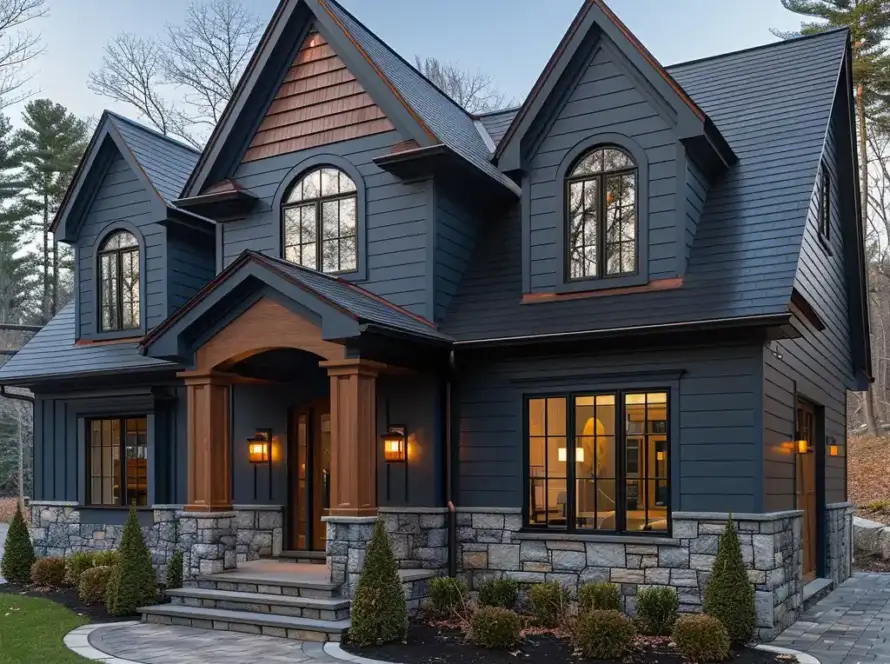

4 Comments
Pier
Hi everyone!
What are the hidden costs of siding replacement that homeowners should be aware of?
John S.
Great question!
Some hidden costs of siding replacement that homeowners should consider include:
Removal and disposal of old siding – This can add hundreds to thousands of dollars depending on the size of your home.
Repairing underlying damage – Issues like water damage, rot, or pest infestations under the existing siding often aren’t visible until removal begins.
Upgrading insulation – Many homeowners take this opportunity to improve energy efficiency by adding house wrap or rigid foam insulation.
Permit fees – Some municipalities require permits, which come with their own costs.
Customizations or trim work – Decorative features, corner posts, and soffits can increase the final bill.
Always ask your contractor for a detailed estimate and clarify what’s included upfront to avoid surprises.
homeowner_emma84
Really helpful breakdown of siding costs and timelines! Quick question — how do different siding materials (like vinyl, fiber cement, and wood) hold up in regions with extreme temperature swings and moisture? Also, do you have any data on long-term ROI for premium siding compared to more budget-friendly options over a 5–10 year period?
John S.
Vinyl siding is affordable and relatively low maintenance, but it can become brittle in very cold climates and may warp in extreme heat. It holds up reasonably well in moist conditions but isn’t the most durable long-term solution.
Fiber cement siding performs well in regions with temperature swings and high humidity. It’s resistant to rot, pests, and fire, making it a great long-term investment — though it’s heavier and more expensive to install.
Wood siding offers a classic look but requires regular maintenance. It’s less resistant to moisture unless properly sealed and painted, and extreme climates can cause it to expand, contract, or warp over time.
As for ROI, fiber cement often ranks highest — according to national remodeling reports, it can return up to 68–77% of the initial investment upon resale. Vinyl comes in slightly lower, usually in the 60–70% range, while wood varies widely based on upkeep and regional market preferences.
Let us know if you’d like a full comparison chart — we’d be happy to include it in a future post!